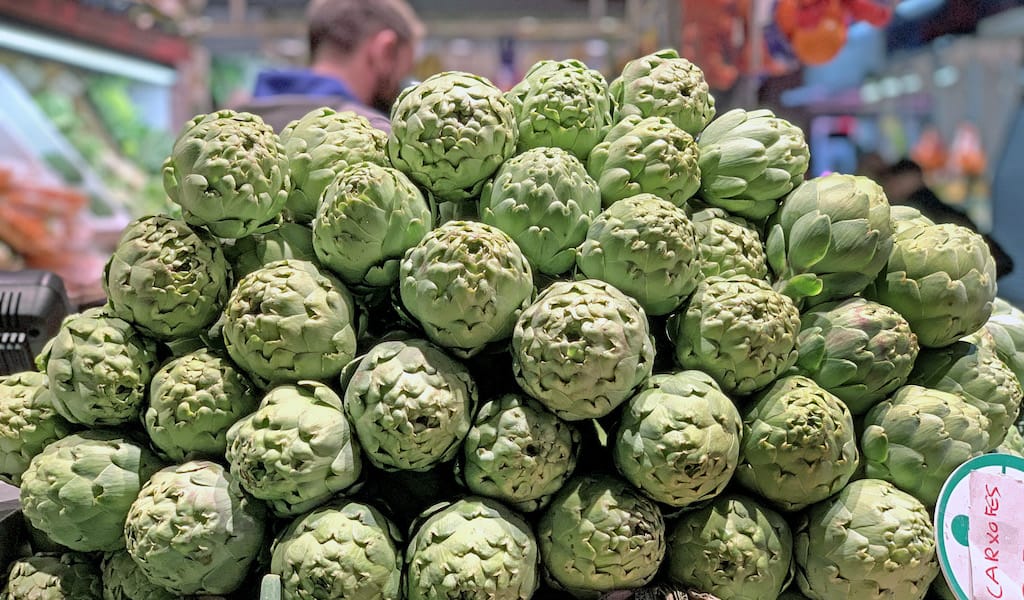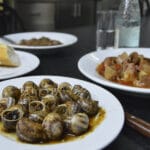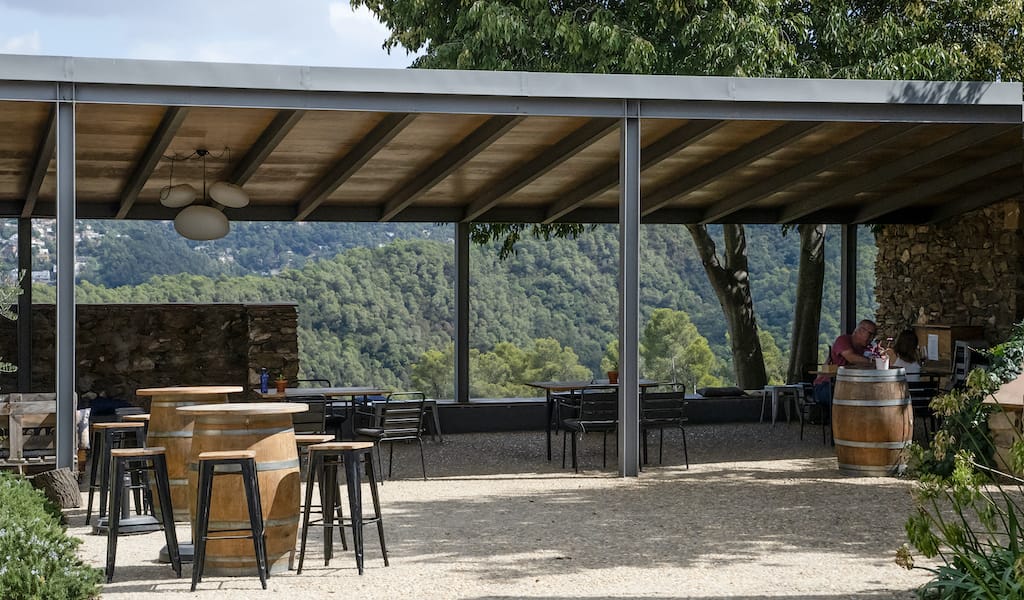Prickly yet pretty, bitter but sweet, medicinal and succulent, at once firm and tender – it’s no surprise the multifaceted artichoke is the queen of Barcelona’s winter produce. It’s also one of the city’s most local crops, grown in fields that literally abut Barcelona’s international airport, just some 10 kilometers out of town.
Originally from North Africa (most likely Egypt), the artichoke’s appearance in Spain is documented as early as the 1st century AD by Spanish-Roman agronomy writer Lucius Junius Moderatus Columella, who mentions them in his work De re rustica. As the Moorish agriculturist Ibn Al-‘Awwam noted in his Book on Agriculture, by the 12th century the cultivation of artichokes was widespread throughout the Iberian peninsula. Today, Spain is the third largest producer of artichokes in the world, after Italy and Egypt, growing more than 200,000 tons per year, with the greatest part of the cultivation concentrated in the east of the country. Catalonia grows around 9,000 tons of artichoke per year, with two main areas of cultivation: around the Ebro Delta in south Tarragona and in Barcelona’s Baix Llobregat agricultural region.
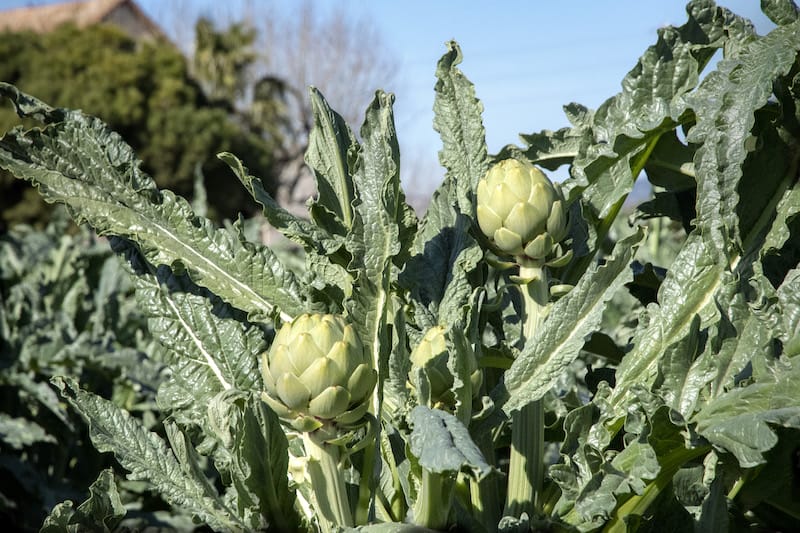
This region brings together 14 smaller agricultural districts in Barcelona province, including El Prat and Sant Boi – two areas that are locally synonymous with the word “artichoke.” At markets and shops, these two locations are proudly displayed on signs advertising the flower-like vegetable, whose growing season stretches from November to April, with its peak at the start of the year.
Although El Prat is also associated with Barcelona’s airport (officially called Josep Tarradellas Barcelona-El Prat Airport), this village is, in fact, surrounded by fields that provide the city with many of its most local products, especially artichokes. What makes the culinary magic possible here is the especially fertile and mineral-loaded Llobregat River Delta, which waters the fields of the area.
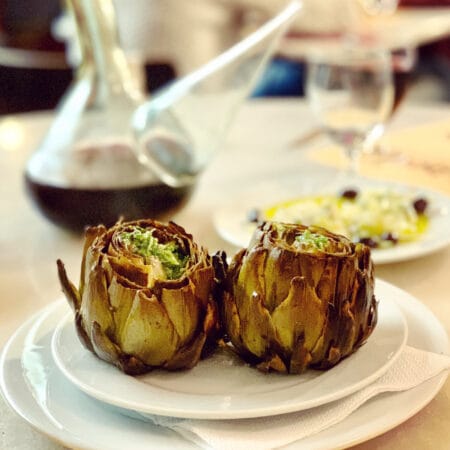 Furthermore, the surrounding mountains and sea help protect and regulate the temperatures of El Prat. In this area, artichokes have been the main crop since the start of the 20th century, with about 500 hectares of fields concentrated in the El Prat and Sant Boi municipalities. Although several decades ago these local artichokes used to be exported to other parts of Europe, today they mostly stay in the Barcelona area, as urban development has led to reduced cultivation capacity.
Furthermore, the surrounding mountains and sea help protect and regulate the temperatures of El Prat. In this area, artichokes have been the main crop since the start of the 20th century, with about 500 hectares of fields concentrated in the El Prat and Sant Boi municipalities. Although several decades ago these local artichokes used to be exported to other parts of Europe, today they mostly stay in the Barcelona area, as urban development has led to reduced cultivation capacity.
Having survived as a local crop, these artichokes have become a symbol of agricultural production in the region, and many local restaurants pay tribute to them on their menus. One of the most specialized is CèNTRIC Gastro, a restaurant run by chef Susana Aragón in the Cèntric Cultural Center in El Prat.
The philosophy at CèNTRIC gastro is focused on the traditional production of the surrounding agricultural area, including its two most important products: the artichoke and the Catalana chicken. (The latter is known for its bluish-hued shanks, hence its Catalan name Pota Blava, literally meaning “blue leg.”) CèNTRIC Gastro also emphasize their commitment to sustainability, gender equality, ecology and social justice, and have created a relaxed and comfortable space that is popular for families and friends looking to enjoy some weekend sun on their big terrace.
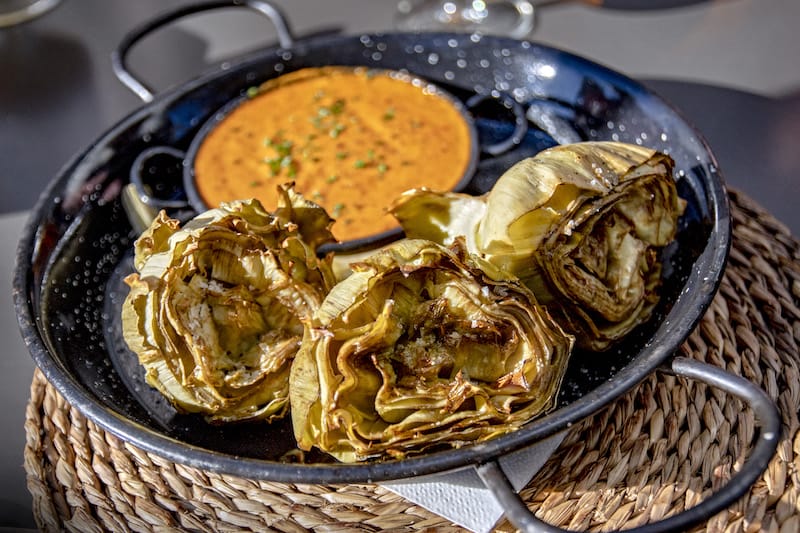 The menu includes artichokes cooked in every possible way: from elaborate rice dishes – like their delicious, seasonal creamy rice with tender scallops and black garlic topped with fried artichokes on top – to a fantastic paella-style dish that combines both the local artichoke and chicken. The latter is probably the must-try of the house. Whether they are baked, fried, folded into gyozas or cooked with squids, Catalan sausage, eggs… El Prat artichokes are everywhere, even as part of the bathroom decor!
The menu includes artichokes cooked in every possible way: from elaborate rice dishes – like their delicious, seasonal creamy rice with tender scallops and black garlic topped with fried artichokes on top – to a fantastic paella-style dish that combines both the local artichoke and chicken. The latter is probably the must-try of the house. Whether they are baked, fried, folded into gyozas or cooked with squids, Catalan sausage, eggs… El Prat artichokes are everywhere, even as part of the bathroom decor!
During artichoke season, it’s easy to find this delicious bud in a variety of restaurants inside Barcelona itself. Masias (farmhouse restaurants in the countryside) are great places for traditional preparations, while back in town, classic spots like Cal Boter, La Llesca, Bodega Bartolí or La Cova Fumada are also reliable stops for simple yet delicious artichoke dishes.
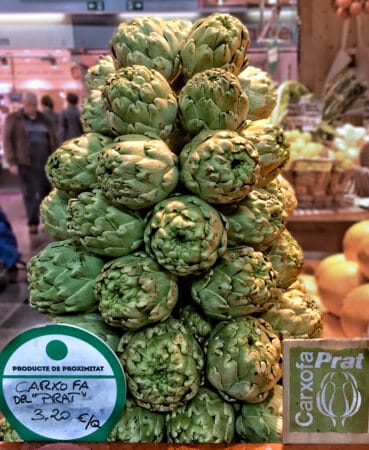
Many bars, meanwhile, serve artichokes in omelets or fried to dip in Romesco sauce. Ultra-modern or fine-dining establishments may also have this big green Mediterranean pearl as a standard seasonal item on their menus, making appearances in rice dishes, as an olive-oil confit, in tempura or many other creative dishes.
Places like the fantastic Olivos Comidas y Vinos, la Panxa del Bisbe or Granja Elena never miss out on artichoke season, and the best pizzerias incorporate them too. Pizzeria Balmesina has a pie with El Prat and Straccino cheese (from local cheesemaker Pinullet) and another with artichoke and pancetta. But even dessert can bring this glorious and super healthy beauty to the peak of culinary satisfaction – in a lucky year, you will find a seasonal sorbet of El Prat artichoke made by Paralel·lo Gelato, best paired with their lemon and ginger sorbet.
Published on March 25, 2022
Related stories
September 15, 2022
BarcelonaIt has been an endless summer in Barcelona. The temperatures are historically high and use of public air-conditioning historically low due to government-imposed energy saving measures. We are learning to live with what looks like a constant heat wave, where the best hours of the day start at night. The city is now recovering its…
May 20, 2022
BarcelonaPulpo (octopus) is more than just a staple food in Galicia (the autonomous community in northwest Spain); it is an icon, a national symbol venerated by Galicians as well as Spaniards across the country. In Galicia, this cephalopod is consumed at traditional village fairs, and is sold on weekends at street stalls. These stands are…
May 13, 2022
BarcelonaEight, six, or even just four hours in Barcelona’s airport are enough to take a cab or the Aerobus and jump into the city. The ride from the airport to the center takes around twenty-to thirty-minutes, and is really worth it to escape from the capsule of the airport – and that feeling of being,…







































